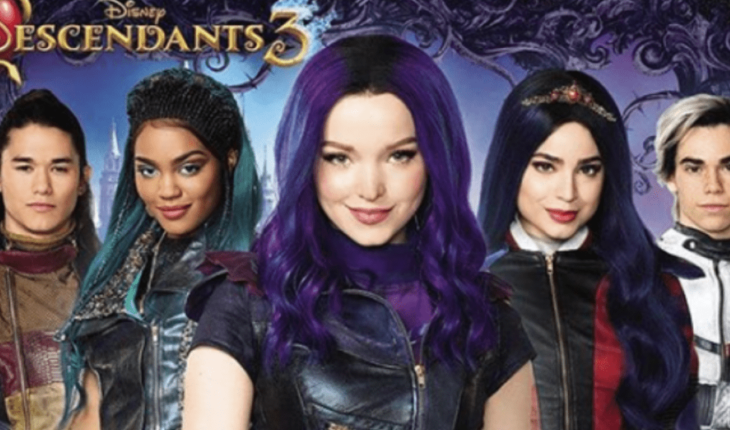The villains’ children return for the third time to save the day and prove that not everything is as black and white as Disney made us believe all this time. Since the first instalment of Descendants, Maléfica’s daughter, Evie (daughter of the Evil Queen of Snow White), Carlos (son of Cruella de Vil) and Jay (the son of Jafar) have been breaking down barriers – figurative and literal – between the world of heroes and that of the villains , by the strength of songs and lessons on friendship. The kingdom of Auradon is endangered once again because of an inhabitant of the Isla of the Lost, from where They are originating Mal and company. They return to recruit the new candidates from the program inaugurated by Prince Ben, the same one who gave them a chance in the first film. Auradon High Will receive four lucky ones to have a formal education, chosen by the original VKs therefore (the cool name of the protagonists: villain kids).
The opening number has a rhythm and an aesthetic that would be the envy of any production of Cris Morena
It all starts with a very “little light”-style musical number, portraying the island’s children as if they were lost, hungry and ragged, even though some of their parents are present. The picture works as a presentation to tell the boys on the island (and the audience on the other side) that the opportunity they’ve finally hoped for all their lives has finally arrived. Here the first seed of the conflict is already raised, for in the following scenes Mal will make the controversial decision (in secret from his friends) to take away that opportunity forever. It’s all laughter and fun until Hades attacks the VKs when they’re leaving the island with the four selected, following the promise that they’ll be able to revisit their parents. But at that moment, the underworld god makes his triumphant entrance to try to create a magical gap in the barrier that separates them from the prosperous kingdom of Auradon.
The VKs are no longer the children they were when they first arrived in the kingdom of Auradon and they are very clear where they belong
After confronting him, Mal feels weak because of a magic ember in Hades’ possession, of which little is known about its origin and functioning. However, friends manage to escape and upon arriving in Auradon we learn that the ember represents a danger of the same magnitude as Maleficent’s staff. To all this, such a magical object rests in a museum and will be stolen by one of the characters of the first film to put the kingdom in greater danger, but this time from within. From this moment on, smaller conflicts begin to occur, one after the other, which arise as real dilemmas and yet are soon set aside. Resolutions are incredibly easy and nothing seems to have consequences. Not even when Mal lies to all his loved ones, betraying the ideals for which VKs have advocated since the first installment of “Descendants”, when they were also children who had another chance.
The appearance of Hades is one of the most interesting elements of this new installment, although it remains quite aside
Curses are undone just as easily as they are made and magic does not respond to clear rules, except when it is convenient to plot. At some point there is a certain reversal of roles that is diluted between so much paraphernalia and the conflicts are as weak as the motivations of its protagonists. There is no shortage of references to classic Disney animated films and even legends of Greek mythology, although there is no other justification than the sporadic presence of Hades.The dramatic weight of one of the greatest revelations in history is reduced to a musical number that generates some discomfort, and in the end only serves as an excuse to reverse another curse. The opportunity to explore a very interesting topic concerning fatherhood is sadly wasted, in pursuit of the spectacularity of a type of “villana” that we have already seen a thousand times. By this point in the game, Disney should have forever released the clashes between “resentful” women whose sole purpose in life is to marry the prince.
Nor do the daughters of the villains save from the imposition of marriage at an early age as a definitive version of the “happy forever”
But it’s not all dark magic and archetypes from a bygone era: one of the most popular characters from the previous sequel, which has great growth in this final installment, also reappears. From its bow emerges the strongest and most positive lesson of the film, in the relationship of the protagonists with a group of “enemies” as harmless as they are alike to them. The message of forgiveness and tolerance that runs through the saga since its inception, again gathers strength almost at the end to remind us why it was a success from the first film. With another approach, the whole story could function as a powerful metaphor for the differences between the most privileged and the least favored by the circumstances of life. But morality is as lazy as the narrative and is ultimately puerile entertainment that claims nothing more than that.
The children of other classic Disney villains who appeared in the second part return to add more nuance to the story
However, the mouse factory does what we do best and fills our retina with aesthetically flawless images and ears of catchy rhythms and easy-to-remember letters. The production design is all you would expect from a fairy tale and the practical sets are very skillfully combined with the limited TV budget on VFX. The characters in this trilogy will always be remembered by an entire generation like those who came to change the dynamic between heroes and villains, even if that change remains confined to the rigid rules of the game. And while they didn’t kick the board as hard as it needed, they at least laid the groundwork for a game with other rules and other players. In this note:





